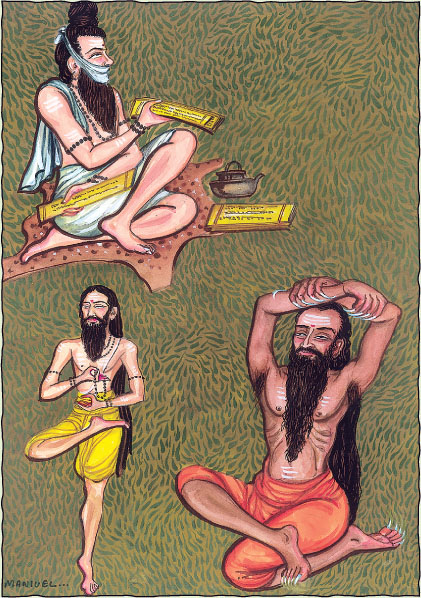THE NINTH OBSERVANCE
Recitation
Japa जप
 OW WE SHALL FOCUS ON JAPA, RECITATION OF HOLY MANTRAS, THE NINTH NIYAMA. HERE AGAIN, A GURU IS ESSENTIAL, UNLESS ONLY THE SIMPLEST OF MANTRAS ARE RECITED. The simplest of mantras is Aum, pronounced “AA, OO, MMM.” The AA balances the physical forces when pronounced separately from the OO and the MMM, as the OO balances the astral and mental bodies. The MMM brings the spiritual body into the foreground. And when pronounced all together, AA-OO-MMM, all three bodies are harmonized. Aum is a safe mantra which may be performed without a guru’s guidance by anyone of any religious background living on this planet, as it is the primal sound of the universe itself. All sounds blended together make the sound “Aum.” The overtone of the sounds of an entire city would be “Aum.” In short, it harmonizes, purifies and uplifts the devotee.§
OW WE SHALL FOCUS ON JAPA, RECITATION OF HOLY MANTRAS, THE NINTH NIYAMA. HERE AGAIN, A GURU IS ESSENTIAL, UNLESS ONLY THE SIMPLEST OF MANTRAS ARE RECITED. The simplest of mantras is Aum, pronounced “AA, OO, MMM.” The AA balances the physical forces when pronounced separately from the OO and the MMM, as the OO balances the astral and mental bodies. The MMM brings the spiritual body into the foreground. And when pronounced all together, AA-OO-MMM, all three bodies are harmonized. Aum is a safe mantra which may be performed without a guru’s guidance by anyone of any religious background living on this planet, as it is the primal sound of the universe itself. All sounds blended together make the sound “Aum.” The overtone of the sounds of an entire city would be “Aum.” In short, it harmonizes, purifies and uplifts the devotee.§
One might ask why a guru is important to perform such a simple task as japa. It is the śakti of the guru, of the Gods and the devas that give power to the mantra. Two people, a civilian and a policeman, could say to a third person, “Stop in the name of the law.” The third person would only obey one of them. The one who had no authority would not be listened to. In this example, the policeman had been initiated and had full authority. Therefore, his mantra, “Stop in the name of the law,” seven words, had the desired effect. The person who had not been initiated said the same words, but nobody paid any attention to him. Now, this does not mean one can choose a guru, study with the guru, become accepted by the guru, feign humility, do all the right things and say all the right words, become initiated, receive the mantra and then be off into some kind of other activities or opt for a more liberal path. The guru’s disdain would diminish if not cancel the benefits of the initiation, which obviously had been deceptively achieved. This is why siddhānta śravana (choosing your path carefully) and mati (choosing your guru carefully, being loyal to the sampradāya, to your guru and his successor or successors and training your children to be loyal to the sampradāya) are the foundation of character that the first fifteen restraints and practices are supposed to produce.§
Mantra initiation is guru dīkshā. Traditionally, the family guru would give mantra dīkshā to the mother and the father and then to the young people, making the guru part of the family itself. There is no way that mantras can be sold and be effective. There is no way that the dīkshā of mantra initiation, which permits japa, could be effective for someone who was not striving to fulfill the first seventeen of the yamas and niyamas. Any wise guru would test the devotee on these before granting initiation. There is no way a mantra can be learned from a book and be effective. Therefore, approach the guru cautiously and with a full heart. When asked if you are restraining yourself according to the ten yamas, know that perfection is not expected, but effort is. And if you are practicing the first seven niyamas, know that perfection is not expected here either, but regular attentiveness to them is. You, the guru, your family and your friends will all know when you are on the threshold of mantra dīkshā, which when performed by an established guru is called guru dīkshā.§

